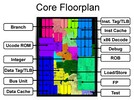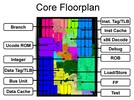AMD E2-3800 vs AMD A4-5050
AMD E2-3800
► remove from comparison
The AMD E2-3800 is a mobile quad-core SoC for low-end laptops, which was presented in November 2013. In addition to 4 CPU cores with a clock speed of 1.3 GHz (no Turbo), the 28-nanometer chip also integrates a Radeon HD 8280 GPU, a single channel DDR3(L)-1600 memory controller as well as the Southbridge with various I/O- ports.
Architecture
Both Kabini (for notebooks) and Temash (tablets and compact subnotebooks) are based on AMD's new Jaguar architecture, which replaces the previous Bobcat models (e.g. the E-350). The performance per clock has been increased by about 20 percent. Furthermore, various modern instruction set extensions such as SSE up to version 4.2, AVX and AES are now supported. The finer 28-nanometer process from TSMC allows lower voltages and/or higher clock rates compared to Bobcat, as well as up to 4 CPU cores (Bobcat: 2 cores).
Performance
Due to the low clock speed of 1.3 GHz, the performance in poorly parallelized applications is quite modest and just slightly above the old E-350. However, if all 4 cores are busy, the performance equals the Sandy-Bridge-based Core i3-2357M. For office and multimedia tasks, the E2-3800 has sufficient power; however, it will reach its limits in more demanding applications and games.
Graphics
The SoC integrates a Radeon HD 8280 GPU with 128 shaders, which is based on the GCN architecture and clocked at 450 MHz (no Turbo). On average, the HD 8280 places slightly below a Radeon HD 7470M or Intel HD Graphics 4000. Many recent games (as of 2013) are therefore hardly playable. However, some older or less demanding games will run fluently.
Power Consumption
The power consumption of the entire SoC is rated at 15 watts. Thus, the E2-3800 is a bit more economical than its predecessors (E2-1800: 17 watts) and suitable for smaller subnotebooks.
AMD A4-5050
► remove from comparison
The AMD A4-5050 is a mobile quad-core SoC for low-end laptops, which was presented in Q1/2014. In addition to 4 CPU cores with a clock speed of 1.55 GHz (no Turbo), the 28-nanometer chip also integrates a Radeon HD 8330 GPU, a single channel DDR3(L)-1600 memory controller as well as the Southbridge with various I/O- ports. The only difference to the A4-5100 is the slightly lower TDP (13.5 W instead of 15 W). Probably, the A4-5050 is an OEM-only model, which is sold exclusively from HP.
Architecture
Both Kabini (for notebooks) and Temash (tablets and compact subnotebooks) are based on AMD's new Jaguar architecture, which replaces the previous Bobcat models (e.g. the E-350). The performance per clock has been increased by about 20 percent. Furthermore, various modern instruction set extensions such as SSE up to version 4.2, AVX and AES are now supported. The finer 28-nanometer process from TSMC allows lower voltages and/or higher clock rates compared to Bobcat, as well as up to 4 CPU cores (Bobcat: 2 cores).
Performance
Due to the low clock speed of 1.55 GHz, the performance in poorly parallelized applications is quite modest and just slightly above the old E2-1800. However, if all 4 cores are busy, the performance equals the Sandy-Bridge-based Core i3-2377M. For office and multimedia tasks, the A4-5050 has sufficient power; however, it will reach its limits in more demanding applications and games.
Graphics
The SoC integrates a Radeon HD 8330 GPU with 128 shaders, which is based on the GCN architecture and clocked at 500 MHz (no Turbo, clock not confirmed yet). On average, the HD 8330 matches a Radeon HD 7470M or Intel HD Graphics 4000. Many recent games (as of 2013/2014) are therefore hardly playable. However, some older or less demanding games will run fluently.
Power Consumption
The power consumption of the entire SoC is rated at 13.5 watts. Thus, the A4-5050 is a bit more economical than the A4-5000/5100 and suitable for even smaller notebooks.
| Model | AMD E2-3800 | AMD A4-5050 | ||||||||||||||||||||||||||||||||||||||||
| Codename | Kabini | Kabini | ||||||||||||||||||||||||||||||||||||||||
| Series | AMD AMD A-Series | AMD AMD A-Series | ||||||||||||||||||||||||||||||||||||||||
| Series: AMD A-Series Kabini |
|
| ||||||||||||||||||||||||||||||||||||||||
| Clock | 1300 MHz | 1550 MHz | ||||||||||||||||||||||||||||||||||||||||
| L1 Cache | 256 KB | 256 KB | ||||||||||||||||||||||||||||||||||||||||
| L2 Cache | 2 MB | 2 MB | ||||||||||||||||||||||||||||||||||||||||
| Cores / Threads | 4 / 4 | 4 / 4 | ||||||||||||||||||||||||||||||||||||||||
| TDP | 15 Watt | 13.5 Watt | ||||||||||||||||||||||||||||||||||||||||
| Technology | 28 nm | 28 nm | ||||||||||||||||||||||||||||||||||||||||
| Features | SSE (1, 2, 3, 3S, 4.1, 4.2, 4A), x86-64, AES, AVX, DDR3L-1600 | SSE (1, 2, 3, 3S, 4.1, 4.2, 4A), x86-64, AES, AVX, DDR3L-1600 | ||||||||||||||||||||||||||||||||||||||||
| iGPU | AMD Radeon HD 8280 (? - 450 MHz) | AMD Radeon HD 8330 (? - 500 MHz) | ||||||||||||||||||||||||||||||||||||||||
| Architecture | x86 | x86 | ||||||||||||||||||||||||||||||||||||||||
| Announced | ||||||||||||||||||||||||||||||||||||||||||
| Manufacturer | www.amd.com |
Benchmarks
Average Benchmarks AMD E2-3800 → 0% n=0
* Smaller numbers mean a higher performance
1 This benchmark is not used for the average calculation












